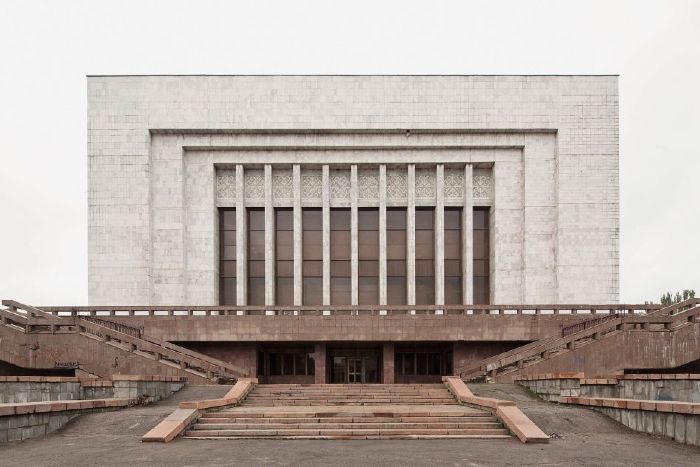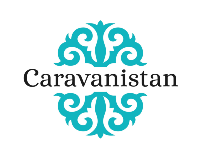Bishkek, the capital of Kyrgyzstan and its main transport hub, is a Soviet-built city of big boulevards and aging high-rises of around 1 million inhabitants.
Tourists will be drawn to the bazaars and parks, and the relics of the Soviet empire visible at every step. If you are into nightlife or fine dining, Bishkek is your best chance; the rest of Kyrgyzstan has no such offers.

Quick links: Transport – Accommodation
History
Bishkek doesn’t have any dramatic past lives. Although this part of the Chuy Valley was populated by Turkic nomads and Sogdians from at least the 8th century, their numbers rising and falling with the fortunes of the Silk Route, this civilization was nipped in the bud in the 13th century when Genghis Khan passed through.
A town only came into being in the middle of the 19th century, as a small settlement on a caravan route through the Tien Shan mountains. The name of the area in the Sogdian language, Peshagakh (‘place under the mountains’) sounded enough like pishpek, a wooden ladle used for stirring kymys, that in 1862 when Russian commanders arrived from nearby Verniy (Almaty) to capture the settlement, they called their military garrison Pishpek.

In the coming decades Russian peasants flocked to Pishpek, to take advantage of the fertile black soil of Kirgizia’s Chuy Valley, lured by the offer of free land. By 1926 the town was large enough to become the capital of the newly established Kyrgyz Soviet Socialist Republic.
Pishpek was renamed Frunze, after its most renowned son Mikhail Frunze, the Russian Civil War commander who had a big hand in securing Bolshevik supremacy over Central Asia against local basmachi opposition. After the Second World War, as prosperity and population grew during the baby boom years, Bishkek was transformed into a modern Soviet town.

Post-independence
At the end of the Soviet era in 1991, the capital of independent Kyrgyzstan was renamed once again, this time to Bishkek. With the collapse of the Soviet Union came widespread poverty, crime and anarchy.

Russian influence over Bishkek faded as many descendants of the early settlers migrated to Russia, allowing Kyrgyz to add their own flourishes to their capital, such as murals by Kyrgyz artists on many of the city’s newer housing blocks.

Transport and accommodation
Bishkek is Kyrgyzstan’s main transport hub. All you need to know to get in, out and around Bishkek can be found on the Bishkek transport page.
For our tips on accommodation, see Where to stay in Bishkek?
Things to see and do
Strolling Bishkek
Away from the main traffic arteries, Bishkek is a pleasant city to wander with wide boulevards, leafy parks and sculptures scattered throughout.
The architectural mix of massive Brutalist Soviet concrete and post-collapse, no-rules construction makes for interesting observations. Some standout buildings are the Wedding Palace (Dzhumabeka-Abdrakhmanov str.), the 18-story apartment building, Zhirgal banya (Sultan Ibraimov-Toktogul str), the Kojomkul Sports Complex (Togolok Moldo-Ryskulova), the History Museum, Philharmonia and the Presidential Palace (all on Chuy).
Bishkek walking tours exist, if you’d like to go with a guide.

Bazaars
Dordoi
At over a kilometre long, and with over 20 000 people working there, Dordoi Bazaar is the biggest market in Central Asia. Over 6000 stalls fashioned from double-stacked metal shipping containers sell clothes and cheap Chinese goods.
The bazaar has shrunk in recent years due to changing trade rules. But the place is as chaotic as ever, and nowadays you can plan a day at Dordoi in advance on the market’s own website.

Open from 9 to 16 every day. Several marshrutkas head there from the city center, catch them anywhere along Abdrakhmanova (Sovietskaya) street.
Osh bazaar
Bishkek’s second biggest market can’t compete with Dordoi for size, but it’s right in the center of town and more interesting in the variety of goods on offer on a smaller surface area.
You can find plov spices, tools for poking holes in flatbreads and every possible part of a butchered animal on display, as well as handmade baby cots, kitchen hoods and winter boots. One of the most beautiful parts of the bazaar is the choykhona (tea-house) at its very centre. Cobblers, hairdressers and knive sharpeners ply their trade here, alongside beggars, fortune tellers and mullahs.

Like Dordoi, Osh bazaar is an ecosystem that spreads far and wide, especially in the direction of the bus station, populating the surrounding streets with cheap hotels, eateries, bars and brothels for traders.
Osh bazaar is located between Chuy and Toktogul, and Kuliev and Beshenaliev streets (Gmaps – OSM). It’s open from 9 to 19 every day.
Orto Sai Soviet Flea Market
To seek out treasures with a story, pop in to the Orto Sai flea market on a Sunday morning. Here, traders sell from their collections of Soviet homeware, Lenin medals, old cameras, samovars and bric-a-brac.
Most of the traders are pensioners trying to supplement their meagre pensions. Here you can still hear people scold Gorbachov and bring up memories of holidays in Yalta and the time when bread only cost 20 cents.

Operates every Sunday morning 7-11 on Yunusalieva street, near the regular daily Orto Sai bazaar (Gmaps). We have some more good tips for Bishkek souvenir shopping in the forum. We welcome your input!
Animal market
The Sunday livestock market outside of Bishkek does not have the same fame as that of Karakol, for good reason: the animal market in Karakol is definitely a much cleaner and more civilized affair.
If however you are in the mood for something more “unedited”, come for the mud, the stink, the fights, the butchering and the low-low prices of Bishkek’s Mal bazaar, or in Russian, Skotniy Rynok (Gmaps).
Parks
Bishkek’s parks are its treasure, changing colours throughout the year. The central Oak Park (Gmaps – OSM) has ping-pong tables, squirrels and sculptures. The longer parks (Erkindik in the center and Jash Gvardiya just east of Osh Bazaar) make for nice long evening walks.

Ata Turk Park (Gmaps – OSM) is beautiful in fall and has questionable amusement rides. Other amusement parks aimed at children are Panfilov Park (Gmaps – OSM) and Flamingo Park (Gmaps – OSM).
Museums and galleries
Museums are generally closed on Mondays.
National Historical Museum

Is it ever going to open again? Maybe not. In 2016, $20 million was earmarked for a big renovation. The money is gone, some of the artefacts have disappeared, been buried or gone missing, and the the Communist murals, which were the real highlight, might also have been destroyed already.
A big Lenin pointing the way forward is still posted at the back of the museum. From the outside, the building is a masterpiece of Soviet Modernism.
Museum of Fine Arts
A fine Brutalist building hosts the best collection of figurative art in Kyrgyzstan with works from Russian- and Kyrgyzstan-born artists. Stand-outs are Theodor Herzen’s graphic work on “Manas” and the work of Gaspar Aitiev.

Contemporary art
b’Art is an art NGO staffed by intelligent people doing interesting things, who are happy to tell you more about the contemporary art scene in Bishkek.
“Esoterics” and “Energies” are the main religions in the post-Soviet space these days, and The Great Emptiness museum (Gmaps) is a Rainbow Gathering-esque project by a local artist that pays homage to this world view.
Small museums
If you are staying in Bishkek for an extended period of time and can speak a local language, you might gain an interest in the many small museums Bishkek offers.
Learn Russian
Bishkek is one of the cheapest places to learn Russian. Many people on the street have the same level as you, which makes it feel like you are getting good at it (you’re not). Try London School (Abdrakhmanov/Sovietskaya 39) or the Russian Center of Culture (Erkindik 2/1).
Eating out, events & nightlife
When it comes to nightlife, Bishkek is a lot like a small university town: the quality is generally low but the fun factor is high. Lots of young people that speak a bit of English (and plenty of cheap booze) will make up for lousy deejays and squealing karaoke. If you plan on getting very drunk: watch out for shady people out to rob you.

Bars and clubs open and close with great frequency, we can’t keep up; check (and add to) our forum thread on Bishkek nightlife recommendations. For food, a local, more exhaustive alternative to Tripadvisor is Restoran.kg. For more restaurants tips, head over to the Bishkek for foodies thread.
Event announcements are often hidden away in a myriad of Telegram channels, Whatsapp groups, Facebook pages and Instagram posts, but Get In is a good place to start your search. Our calendar of events and festivals in Kyrgyzstan notes the few recurring events in the Bishkek calendar.
Safety
During the day, Bishkek is a safe city, generally speaking. However, after sunset Bishkek becomes a poorly-lit place awash with drunk men. We advise against walking the streets in the dark by yourself, and to definitely avoid parks at night. Go in groups, or take a bus or taxi. Besides violence or robbery, broken pavements and missing manhole covers can be a serious source of injury.

Pickpockets roam the bazaars. Osh Bazaar is patrolled by fake policemen looking to squeeze a buck out of a foreigner.
Night clubs also attract shady characters. It’s best not to walk from nightclub to nightclub at night unless you are in a big group; instead spend a few som on a taxi. Criminals wait outside bars and clubs to follow and rob drunk foreigners.
Bishkek has a large number of prostitutes and sexually-transmitted diseases are on the rise in Kyrgyzstan and Central Asia. Always take proper precautions if you plan on being sexually active.
It’s been a long time since we have heard about white tourists being harassed by Kyrgyz police (unless they were driving). However, foreigners of South Asian, Chinese and African descent will have to keep their guard up.
Police might approach you on the street. They want to isolate you, take you back to the office and part you from your money. 4 steps in this case: Pretend you don’t understand them, walk away immediately, make a lot of noise and ask passers-by for help, and call your embassy if they chase you. Keep your valuables safe, and keep a photocopy of your passport with you, while leaving the original at your accommodation.
Around Bishkek

For winter sports, see skiing in Kyrgyzstan. For hikers, first port of call is Ala Archa National Park. Need to write more on this and the other outdoor options around Bishkek. It’s a big topic. In the meantime, check out our general advice on trekking in Kyrgyzstan.
Burana Tower, near Tokmok, is the main historical site outside of Bishkek.
